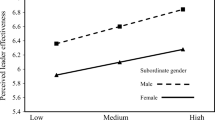Abstract
A 2×2×2 factorial design was employed to examine the influence of instructed leadership style, sex of leader, and sex of followers on leader behavior, subordinate satisfaction, and productivity in a simple task. In general, male and female leaders were equally able and equally willing to display autocratic and democratic leadership styles if so instructed. Similarly, leader sex did not have a significant influence on subordinate satisfaction or productivity either by itself or in interaction with leadership style or follower sex.
Similar content being viewed by others
References
Bartol, K. The effect of male vs. female leaders. Journal of Business Research, 1975, 3, 37–42.
Bartol, K., & Butterfield, D. Sex effects in evaluating leaders. Journal of Applied Psychology, 1976, 61, 446–454.
Bass, B. M., Krusall, J., & Alexander, R. H. Male manager's attitude toward working women. American Behavioral Scientist, 1971, 15, 221–236.
Belasco, J. A., Hampton, D. R., & Price, K. F. Management today. New York: Wiley, 1975.
Broverman, J. K., Vogel, S. R., Broverman, D. M., Clarkson, F. E., & Rosenkrantz, P. S. Sex-role stereotypes: A current appraisal. Journal of Social Issues, 1972, 28, 50–78.
Brown, S. M. Male versus female leaders: A comparison of empirical studies. Sex Roles, 1979, 5, 595–611.
Cecil, E. A., Paul, R. J., & Olins, R. A. Perceived importance of selected variables used to evaluate male and female job applicants. Personnel Psychology, 1973, 26, 397–404.
Chapman, J. Comparison of male and female leadership styles. Academy of Management Journal, 1975, 18, 645–650.
Eskilson, A., & Wiley, M. Sex composition and leadership in small groups. Sociometry, 1976, 39, 183–194.
Hansen, P. Sex differences in supervision. Paper presented at the meeting of the American Psychological Association, New Orleans, 1974.
Helmrich, D. Male and female presidents: Some implications of leadership style. Human Resource Management, 1974, 13, 25–26.
Hobart, C., & Haines, K. Sex role stereotyping among future managers. In J. Jewell (Ed.), Women and management. Atlanta: Georgia State University, 1977.
Jacobson, M., & Effertz, J. Sex roles and leadership perceptions of the leaders and the led. Organizational Behavior and Human Performance, 1974, 12, 383–396.
Lockheed, M., & Hall, K. Conceptualizing sex as a status characteristic. Journal of Social Issues, 1976, 32, 111–124.
Malabre, A. Women at work. Wall Street Journal, August 28, 1978, p. 1.
Massengill, D., & DiMarco, N. Relationship between stereotypes of managers, men and women. Sex Roles, 1979, 5, 561–570.
Osborn, R. N., & Vickars, W. M. Sex stereotypes: An artifact in leader behavior and subordinate satisfaction analysis. Academy of Management Journal, 1976, 19, 439–449.
Peters, L. H., Terborg, J. R., & Traynor, J. Women as Managers Scale: A measure of attitudes toward women in managerial positions. JSAS Catalog of Selected Documents in Psychology, 1974 (Ms. No. 585).
Petty, M. M., & Lee, G. K. Moderating effects of sex of supervisor and subordinate on relationship between supervisor behavior and subordinate satisfaction. Journal of Applied Psychology, 1975, 60, 624–628.
Petty, M. M., & Miles, R. H. Leader sex-role stereotyping in a female dominated work culture. Personnel Psychology, 1976, 29, 393–404.
Petty, M. M., Odewahn, C. A., Bruning, N. S., & Thomason, T. L. An examination of the moderating effects of supervisor sex and subordinate sex upon the relationship between supervisory behavior and subordinate outcomes in mental health organizations. Proceedings of the 37th Annual Meeting of the Academy of Management, 1977, 408–412.
Schein, V. E. The relationship between sex role stereotypes and requisite management characteristics. Journal of Applied Psychology, 1973, 57, 95–100.
Schmidt, S., Kipnis, D., & Wilkinson, I. Power tactics used within organizations. Journal of Applied Psychology, in press.
Smith, P. C., Kendall, L. M., & Hulin, C. L. The measurement of satisfaction in work and retirement. Chicago: Rand McNally, 1969.
Staines, G., Tavris, C., & Jayarant, J. E. The queen bee syndrome. In C. Tavris (Ed.), The female experience. Del Mar, Calif.: C.R.M. Books, 1973.
Terborg, J. R. Women in management: A research review. Journal of Applied Psychology, 1977, 62, 647–664.
Terborg, J. R., & Ilgen, D. R. A theoretical approach to sex discrimination in traditionally masculine occupations. Organizational Behavior and Human Performance, 1975, 13, 352–376.
Terborg, J. R., Peters, L. H., Ilgen, D. R., & Smith, F. Organizational and personal correlates of attitudes toward women in management. Academy of Management Journal, 1977, 20, 89–100.
Author information
Authors and Affiliations
Rights and permissions
About this article
Cite this article
Stitt, C., Schmidt, S., Price, K. et al. Sex of leader, leader behavior, and subordinate satisfaction. Sex Roles 9, 31–42 (1983). https://doi.org/10.1007/BF00303107
Issue Date:
DOI: https://doi.org/10.1007/BF00303107




